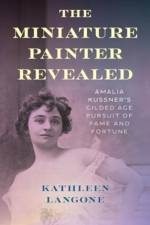av Kathleen Langone
347
From simple beginnings, Amalia Kussner rose to fame as a talented and bold artist and ultimately became one of the most sought-after miniature portrait painters of the Gilded Age. At a time when the use of photography was on the rise, many still loved miniatures, which had a feeling and soul to them that photos could not duplicate. Miniatures could be worn as jewelry or carried between winter and summer homes and easily set out on display. Amalia's portraits provided a grandeur that matched how the Gilded Age elite perceived themselves: as royalty.Yet no female portrait artists had the notoriety or esteemed clientèle that Amalia did. Her subjects included members of the Astor family, Consuelo Vanderbilt, "dollar heiress" Minnie Paget, England's Edward VII, Russia's Czar Nicholas II and Alexandra, and diamond mine magnate Cecil Rhodes. At the height of her career, from the mid-1890s to early 1910, having a Kussner miniature was just as important an accessory as owning fine jewelry or a mansion in Newport. "Famous sitters, drawn to her by the accuracy and skill of her brush, never failed to become life-long friends," read her obituary.Amalia's style was also provocative for the late Victorian period. Her subjects were draped in off-the-shoulder fabrics, with their hair loosely pinned around their heads and tendrils framing their faces, and she often took the liberty to enhance their beauty. Amalia kept the women's best features but gave them an almost mythical appearance, akin to the fairy queen Titania in A Midsummer Night's Dream.Amalia has been included, along with other nineteenth-century women artists, in the "first wave of feminism," in large part because she commanded very high commissions, comparable to male artists of the time. She was fascinating and sometimes mysterious-particularly with regard to her marriage to lawyer Charles du Pont Coudert-and her journey included not only fame and fortune, but also a few lawsuits, scandals, and lies.

